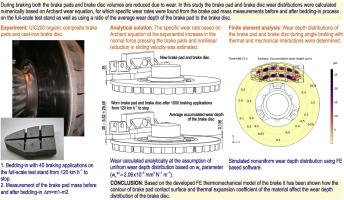FE analysis of the brake pad and brake disc wear with thermal-structure interaction
IF 6.1
1区 工程技术
Q1 ENGINEERING, MECHANICAL
引用次数: 0
Abstract
Changes in the topography of the contacting surfaces of the friction pair components depend on the load, thermal expansion, wear, etc. In this article a FE model of a railway disc brake to evaluate distribution of the brake pad and brake disc wear depth has been proposed. The novel aspect of the 3D model of the brake assembly is the change in volume due to material loss of both sliding components with thermomechanical interactions. This comprehensive approach allows identifying an effect of the properties of materials and geometric features of the brake such as shape of the brake pads on the ventilated brake disc wear distribution. Computer simulations were performed for the parameters of single braking of a railway vehicle from initial velocity of 120 km/h to stop. In order to determine the brake pad wear according to Archard equation, a concise analytical formulation for the specific wear rate was derived based on the experimental data of bedding-in from full-scale dynamometer bench tests. The brake disc wear rate was found from the ratio of the average wear depth of brake pad to the brake disc. The model was verified by temperature evolutions of the brake disc measured using thermocouples. It was found that reducing thermal expansion coefficient of the brake pad equalized the distribution of temperature, contact pressure and wear depth of the brake pad and brake disc. However in both analyzed variants two circular bands with increased wear were visible on the brake disc working surface.

考虑热-结构相互作用的刹车片和制动盘磨损有限元分析
摩擦副部件接触面形貌的变化取决于载荷、热膨胀、磨损等。本文提出了一种铁路盘式制动器的有限元模型,用以评估刹车片的分布和制动盘的磨损深度。刹车组件3D模型的新颖之处在于,由于两个滑动部件的材料损失和热机械相互作用,其体积发生了变化。这种综合的方法可以识别材料特性和制动器的几何特征的影响,例如刹车片的形状对通风制动盘磨损分布的影响。对轨道车辆从初速度为120km /h到停车的单次制动参数进行了计算机仿真。为了根据Archard方程确定刹车片的磨损情况,根据全尺寸台架测功机的磨合试验数据,推导出了比磨损率的简明解析公式。通过刹车片的平均磨损深度与刹车片的平均磨损深度之比,求出刹车片的磨损率。利用热电偶测量制动盘的温度变化,验证了模型的正确性。研究发现,减小刹车片的热膨胀系数使刹车片和制动盘的温度、接触压力和磨损深度分布均匀。然而,在分析的两种变体中,在制动盘工作表面上可以看到两个磨损增加的圆形带。
本文章由计算机程序翻译,如有差异,请以英文原文为准。
求助全文
约1分钟内获得全文
求助全文
来源期刊

Wear
工程技术-材料科学:综合
CiteScore
8.80
自引率
8.00%
发文量
280
审稿时长
47 days
期刊介绍:
Wear journal is dedicated to the advancement of basic and applied knowledge concerning the nature of wear of materials. Broadly, topics of interest range from development of fundamental understanding of the mechanisms of wear to innovative solutions to practical engineering problems. Authors of experimental studies are expected to comment on the repeatability of the data, and whenever possible, conduct multiple measurements under similar testing conditions. Further, Wear embraces the highest standards of professional ethics, and the detection of matching content, either in written or graphical form, from other publications by the current authors or by others, may result in rejection.
 求助内容:
求助内容: 应助结果提醒方式:
应助结果提醒方式:


